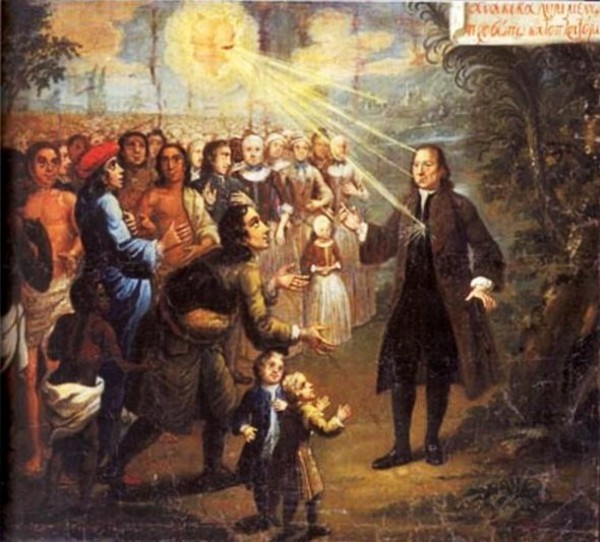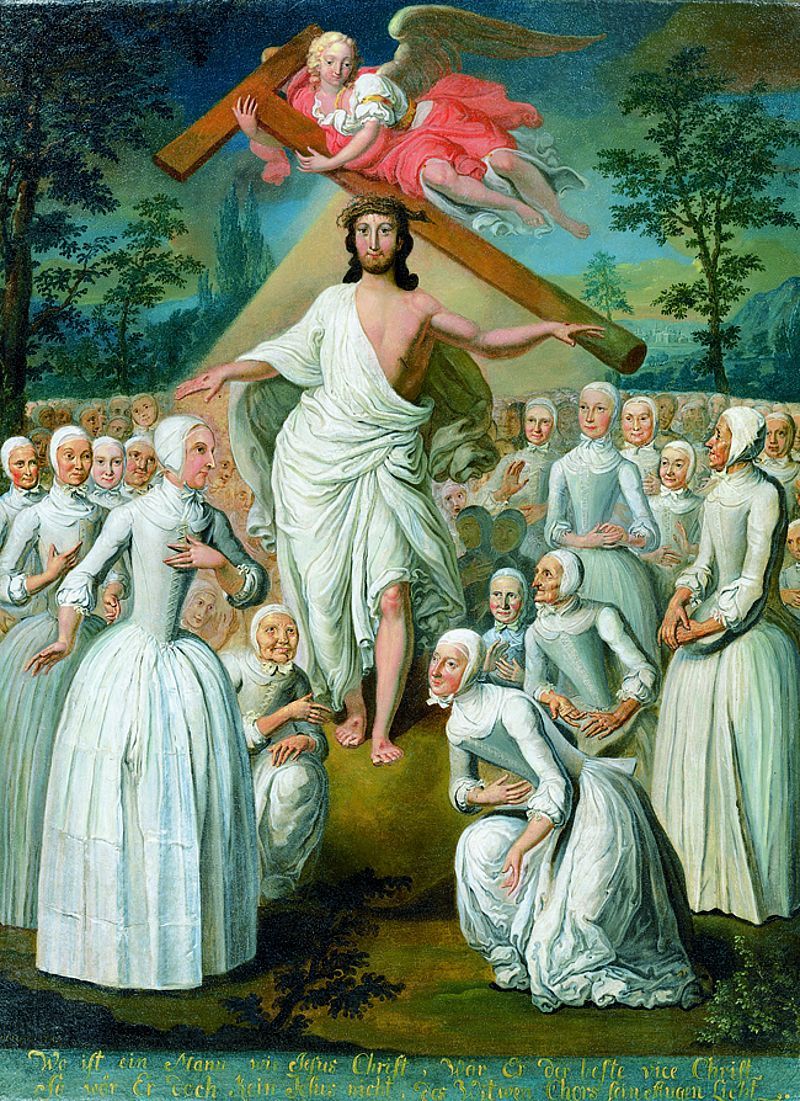
The Moravian Brethren, or the Unitas Fratrum is a Protestant evangelical movement which had a profound influence on events in Europe in the eighteenth century and globally through their tireless missionary work to all ends of the globe. They were not inherently apocalyptic, but there is one period in the mid eighteenth century with distinct apocalyptic elements, which were subsequently harnessed and curtailed. In hindsight this was their most provocative and formative period, with repercussions far into the nineteenth and early twentieth centuries.
The Moravian Brethren trace their heritage back to the pre-Reformation movement in Bohemia in the fifteenth century, to the United Brotherhood church. After the implementation of Catholic rule in the kingdom, the United Brotherhood church was forced to go underground, or into exile. Some, for example, went to Berlin, and in 1722 a group of 30 German-speaking Moravians turned up on the estate of the Imperial count, Nicolaus Ludwig von Zinzendorf (1700-1760) in Berthelsdorf in Eastern Saxony. Zinzendorf had grown up in a Pietist household, had attended Franke’s school for aristocratic boys in Halle, and so was raised within the tradition of emphasis on the conversion experience of the individual believer over against church dogmatism. In his time, Zinzendorf was a highly divisive figure, a charlatan to some, and a genius to others. He was an immensely prolific writer and speaker, a very eclectic thinker, and travelled extensively
Zinzendorf claimed to have had a very close relationship to his saviour, Jesus with whom he was in direct contact and received advice on the maintenance and development of the community. One of the ways in which this was done, was by throwing lots in decision making, by which it was believed that the saviour was making his will known to the leaders. This leads to my first out of two examples of the presence of apocalyptic thought in Moravian history. By apocalyptic thought I mean the cosmic point of view presented in many apocalyptic writings, where the true order and meaning of the world is generally hidden but revealed to a select few, indicating an open line between heaven and earth. In the Moravian community in the 1740s and 1750s, this manifests itself in first the presence of the Saviour within the congregation and the belief that the end-time was already fulfilled in their rituals.
Both of these examples are connected to the community organisation of the Moravian Brethren. From the early 1740s, the Moravian communities were divided into so-called Choirs, which were groups according to sex and marital status. Generally, there were eight Choirs: Children, Girls, Boys, Single Sisters, Single Brothers, Married Couples, Widows, and Widowers. Through speeches and rituals, each of these groups were professed to stand in a unique relationship with the Saviour. For the women, it was mainly in a submissive spousal relation, for the men primarily as one of identity, given their physical likeness to Jesus the man.

The Moravians in the 1740s and 1750s believed their saviour to be present among them in their choirs. Jesus, the crucified human, was thought to walk among his community with broken eyes, pale lips and perforated hands, blowing his grave-breath on his believers, and letting them take refuge in his side wound. This presence was incredibly strong, and cultivated through speeches, singing, and liturgy. This figure is mainly Zinzendorf’s idea, and as far as I can tell, the corpse-focus disappeared after Zinzendorf’s death in 1760, but the idea of a human Jesus and his personal relation to his people continued to prevail and influenced thinkers in the nineteenth and early twentieth centuries, such as Schleiermacher and Gustaf Dalman.
The second example is connected to what is known as the Sifting Time in Moravian historiography, which went from around 1748 to 1750 or so. The term sifting time comes from Luke 22.31, and a reference to Satan’s sifting of the believers as wheat. In Moravian historiography it refers to various times of trial and crisis in the community, but THE sifting time, is the one I talk about here. It is closely related to Zinzendorf’s idea of marriage as it developed in the 1740s. From the mid-1740s, Zinzendorf professed the idea of procurator marriage, which meant that in a marriage, the husband was a procurator, or stand in for Jesus, while the wife was a representative of the church. Every time they had intercourse, they were enacting the relation between Christ and his church, as expressed in Ephesians 5. However, in the afterlife, all men would return to their original female state and be part of the general copulation with Christ. In 1748, in Herrnhaag, a Moravian settlement in Western Germany, which was established after Zinzendorf’s expulsion from Saxony, the single brothers’ choir performed a gender-changing ceremony, proclaiming themselves to be sisters, and as such did not need to wait for the end time to have this reality present. Zinzendorf’s son, Christian Renatus, known as Christel, was the head of the choir and carried out the ceremonious transformation.
As Paul Peucker notes in his study,[1] Zinzendorf himself had carried out a number of ceremonies which were lead ups to this event, in sermons proclaiming the end of masculinity, and in liturgies which blended together the choirs of the single sisters and single brothers (here we may think of the influence of Galatians 3.28). The gender changing ceremony was an absolution of past and future sins, enabling the present transformation, as Peucker points out. This, as we know from 1 Corinthians, can lead to all kinds of things, ordinarily regarded as sinful, but since sin is no more, is not an issue. Communion was discarded, and Peucker suggests, sexual intercourse outside marriage was practiced, believed to be spiritual practice without sin. When rumours of this became known, the leadership acted. The choir was dissolved, people were sent to different communities, various teachings were forbidden, and they managed to channel the crisis into some kind of productive change.
My current research is looking at precisely how this channelling took place, and so here I merely gesture to two of the most important things. In the early 1750s, a change happened in the perception of Moravians. Instead of being regarded as a perverted and subversive sect, governments began to court them because of their desirable entrepreneurship and ability to create economic growth. Another change is in the increase of gender segregation which was policed much more strictly than in the early 1740s, which meant consolidation of gendered labour tasks: weaving, sewing, domestic service, and laundry for the women, and various trades for the men. Both of these changes meant that events on earth were more in focus, more controlled, and more successful in terms of scope and business practice. In this sense, they really were a new community for a new age.
[1] Paul Peucker, A Time of Sifting: Mystical Marriage and the Crisis of Moravian Piety in the Eighteenth Century (Penn State University Press, 2015).
The purpose of this and other blog posts is to provide an opportunity for researchers to reflect on and raise discussion points about their research and current issues. The views and opinions expressed are those of the author and do not necessarily reflect those of CenSAMM, the Panacea Charitable Trust, or any other organization. The blog post is made available for non-commercial purposes, if you wish to copy and redistribute the blog you may do so without making changes, and you must credit the author and the source (censamm.org). If you wish to make commercial use of this post and its contents, please contact the author directly. Additional information about the terms of use for the website is available at censamm.org/terms.


